The history of the WWII German Hitler Youth Knife and Dagger -
The Hitler Youth ,abbreviated HJ, was a paramilitary organization of the Nazi Party. It existed from 1922 to 1945. The HJ was the second oldest paramilitary Nazi group, founded one year after its adult counterpart, the Sturmabteilung (the SA).
the Hitler Youth was divided in three basic groups: The Hitlerjugend proper, for male youth ages 14–18; the younger boys' section Deutsches Jungvolk for ages 10–14; and the girls' section Bund Deutscher Mädel (BDM).
The following picture explains the anatomy of the Hitler Youth knife.
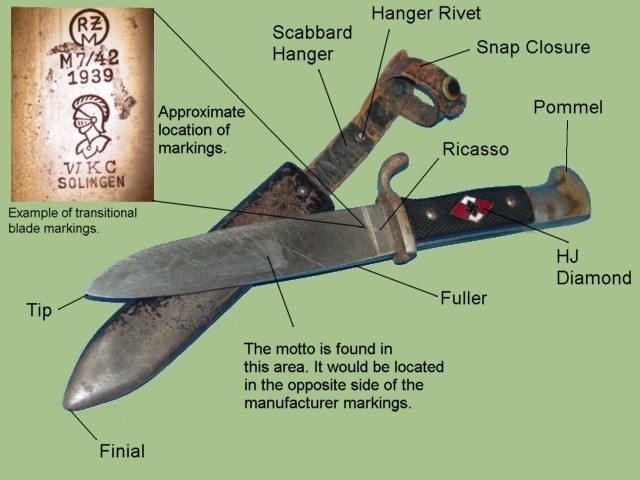
HITLER YOUTH KNIFE
The NSDAP had a youth movement as early as 1922. The Hitler Youth came into existance in 1926. The first leader of
the organization was Adolf Lenk. Membership consisted of small groups. Once Hitler rose to power in 1933 the
number of members increased significantly. A second boost was received in 1934 when all sports and youth organizations
became a part of the Hitler Youth. By 1939 the approximate number of members grew to 9 million.
Membership into the organization was voluntary until 1939. At this point 17 year old kids were required to join the
Hitler Youth. In 1941 service became compulsory for all youths, male and female age 10 and older.
The Hitler Youth started as a part of the SA. Once it branched out into its own organization it retained the same
ranking system as the SA. Additional branches were formed to match the SA in the areas of motor, marine and flying.
This was done as a way to appeal to a wider level of kids.

Several new changes were implemented in 1940. A new person commanded the organization. His name wasArthur Axmann.
His vision for the group was much more militant. Members of the Hitler Youth began to participate in military
maneuvers. Members began to be directly involved in the war effeort. Some of the activities they performed
included Flak Helper (Flakhilfferen). This job consisted in passing anti-aircraft ammunition to Luftwaffe and Army
personnel protecting the cities against bombing raids.
Perhaps one of the most notable contributions to the war made by the Hitler Youth was the formation of the 12th SS
Panzer Hitler Jugend in 1943. This unit served with great honors during the years of 1943 and 1945. The entire division
was made from members of the Hitler Youth. The unit was nearly wiped out at the battle of the Falaise Gap in
Normandy in August 1944.
As the war came to an end, members of the Hitler Youth were sent to fight at the front. As the advancing forces made
their way to Berlin They were facing resistance from kids as young as ten years old. The Hitler Youth made up one of
the last lines of defense against the Russian and American troops.
The Hitler Youth Knife (German: Hitler-Jugend-Fahrtenmesser) was a knife sold to and carried by boys of the paramilitary youth organization of the Nazi Party that existed from 1922 to 1945. The Hitler Youth wore knives as part of their uniform, which was very similar to those worn by the Sturmabteilung or SA. The knife was also given to those who performed exceptionally well in minor exams.
KNIFE ANATOMY
The Hitler Youth Knife was a utilitarian knife. In other words, it
was meant to be used in the field. As expected, when a knife is given to a kid he or she will use it, and not gently.
This is the reason why it is hard to find these knives in mint condition.
The pommel of the knife is a solid metal piece. It has a short extension to one side. the handle is made of plastic and
has a tight checkered pattern applied to both sides of the surface. Two rivets hold the handles in place. The
Hitler Youth diamond is applied to the center of one of the handles. This piece is made of enamel. It has a black
swastika in the center. Red and white patterns are also visible.

The crossguard has one flat side while the other has an extension that curves up. a leather washer is applied to the
base of the blade. This piece affords the knife a better fit when placed in the scabbard. The scabbard is made
of metal and painted black. A small, rounded rivet is found near the throat. The inside will have two white pads
which help guide the blade. Sometimes the pads are missing from the scabbard.
The blade of the Hitler Youth knife was of single edge construction. The early years displayed the motto "Blut und Ehre !"
on the blade. Later models did not have the motto. The blade was plain. Some of the common conditions found in
Hitler Youth knife blades are broken tips, excessive sharpening - Which often cause the motto to dissappear.
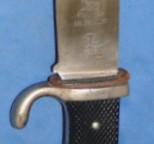 |
The hilt of the blade eveolve over time. The initial version did not have a clearly defined hilt at the base of
the blade (photo on the left). Later versions incorporated a ridge design which clearly identified the hilt
(photo on right).
Notice that the photo on the right shows part of the crossfuard missing. It has broken off. This was probably
caused by heavy duty use and abuse by the owner.
|
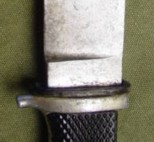 |
MANUFACTURER MARKINGS
The knives were marked in a variety of ways. The markings were applied to the base of the blade or in the general
vicinity. The branding indicated the company that manufactured the knife.
Knives manufactured in the early years were stamped with the manufacturer's logo. In 1934 the RZM organization
was formed. Its purpose was to standardize the manufacturing of items such as the Hitler Youth knife. For the
next few years the blades were stamped with the manufacturer's logo as well as thr RZM equivalent designation
for the maker. Knives produced during this period are known as "transitional". The last set of markings were
known as RZM. Blades were stamped with the RZM logo and the alpha numerical designation for the company.
a list of some of the RZM manufacturers is provided.
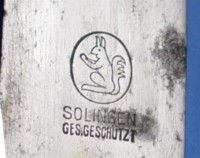 |
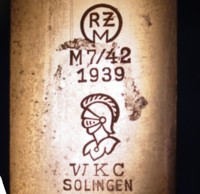 |
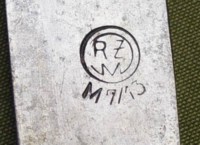 |
| Early marking. |
Transitional marking. |
RZM marking |
ADDITIONAL MARKINGS
The Hitler Youth knives were distributed according to the district where the headquarters were located. In 1937
there were a total of 50 districts. Some of the knives were stamped with the district where they were issued. A
list of the knife markings
is provided in this website.
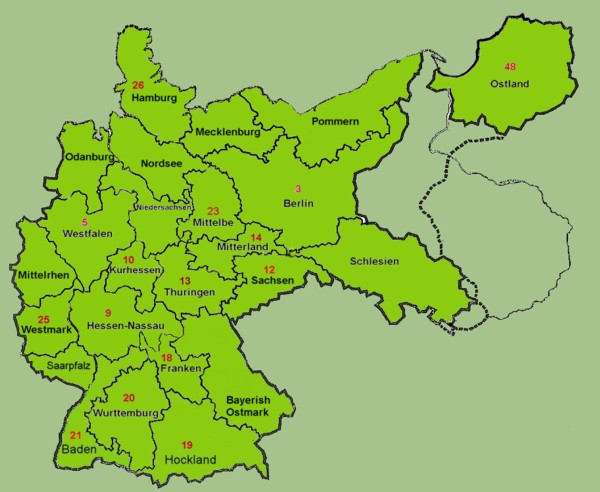 The map shown here illustrates the variuos Hitler Youth districts as of 1937. Notice that hamburg is already
included as it was instituted in this year. The Austrian districts have not been included as they were not
divided until 1938.
The map shown here illustrates the variuos Hitler Youth districts as of 1937. Notice that hamburg is already
included as it was instituted in this year. The Austrian districts have not been included as they were not
divided until 1938.
Each of the districts outlined in the map had a Hitler Youth building (store or warehouse) where the knives
were kept. As youth enrolled in the group they were issued their equipment, including the knife, from this
location. Each district could order directly from the factory producing the knives. For additional
information regarding districts and a newer map refer to the
districts and markings section of this
website.
IDENTIFYING REPRODUCTIONS
The popularity of the Hitler Youth knife has spawned a series of companies that manufacture replicas of the knife.
A couple of simple ways in which to determine if the knife is original or not are illustrated here:
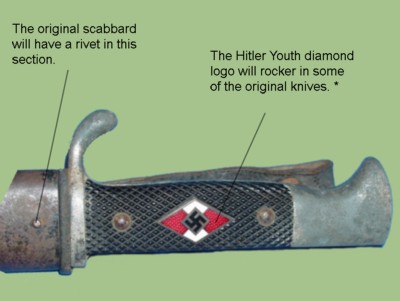 |
* The best way to determine if the Hitler Youth diamond logo moves is to face that section of the handle towards
the floor. Lightly touch one end of the diamond With one finger. You should feel it rocker slightly. It is
important to note that not all of the original diamonds will rocker. Whether they move or not depends on how
they were mounted by the factory.
Other ways to detect reproductions include the dimension of the knife. Some of the less expensive fakes are
much larger than the original knife.
The quality of construction is another factore that needs to be reviewed. The reproduction pieces tend to have
|
almost no wear. Sections like the pommel and handguard are too bright on the fake pieces because they have been
newly chromed. Another aspect to look into is the blade markings. If you see the word CHINA anywhere in the
blade you have a reproduction.
HITLER YOUTH FORESTRY KNIFE
Heinrich Cotta (1763-1844), also known as the "pioneer of forestry", established the first private German forestry school in 1811 in what was called the Forestry Town of Tharandt near Dresden. It later became the Royal Saxon Forestry Academy. Cotta studied forestry all his life and has had a profound influence on the profession of forestry and foresters in Europe. Since
those early days forests and hunting have been a big part of German culture. The Third reich was no exception, creating
a forestry department that adhered to Nazi principles. Members of the Hitler Youth participated in forestry related
activities.
The Hitler Youth Forestry knife was a variation of the Hitler
Youth knife. It was issued to Hitler Youth members who worked in the forestry department. Just like its counterpart,
this knife was designed to be functional and was used in the field.
The pommel of the forestry knife is made of plastic. The handle has a tightly checkered pattern. A roundel with
a gold swastia is position at about mid-point. Not much of a handguard is present.
A dark brown leather sheath was issued with the knife. It comes with snaps that secure around the handle. It has
a series of rivets along the edge to make it more duarble. The manufacturer's logo is stamped in the front.

The blade of the Hitler Youth Forestry knife was of stout construction. Of single edge design. The tip has a
slight curvature. The fuller bears the manufacturer's logo, which in this case is the Boker company. There
is no organizational motto anywhere in the blade.

HITLER YOUTH LEADER DAGGER
The Hitler Youth Leader dagger was instituted in 1937. It was awarded to leaders of the Hitler Youth. The person had
to have the rank of Gefolschaftfuhrer or above to receive it. prior to this dagger there was no distinction between
the leaders and regular personnel in terms of edge weapons.
The dagger was issued in a leather case with an embossed cover. A letter of award known as "Urkunde" was given to the
recipient.
The design of the dagger is very simple. It is almost patterned after a letter opener. The pommel was of metal construction
and oval shape. It was amde of aluminum or silver plated. The handle was of wood construction and tightly wrapped
with silver wire.

The crossguards of the dagger were rectangular in shape and fairly long. The sides were decorated with a rope pattern
in relief.
The blade was of double edge construction. Stilleto style. A center ridge covers most of the blade and tapers down
as it approaches the tip. The organizational motto "Blut Und Ehre!" , which translates to "Blood and Honor",
is written on one side of the blade. The other side bears the RZM marking.

The scabbard is of metal construction. It has three metal fittings. One in the throat, one in the mid-section and the
last one in the tip. The throat and middle sections have suspension rings. This is where the hanger attaches to the
dagger. Unlike other edge weapons of the Hitler Youth, this dagger was not meant for functional use. It was simply a
dress item intended to be worn at parades, dinners and other special events.
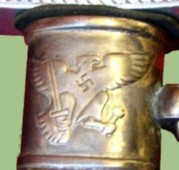 |
The Hitler Youth Leader dagger is adorned with several touches all throughout. For example, the top of the pommel
has the Hitler Youth diamond symbol. The design protrudes from the surface. It has a swastika in the center with
lines that emminate from it.
The throat of the scabbard has a metal fitting which bears the image of an eagle reminiscent of the German Imperial
era. Its wings are extended. One talon is clutching a sword. A swastika is placed in the chest.
|
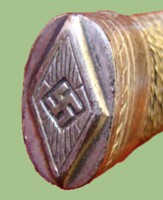 |
The following is a list of some of the companies that manufactured the Hitler Youth knife and dagger during WWII. It
is important to note that these may not be all of the companies that produced the edge weapons.
| Count |
Unique Makers |
Company |
Description |
Logo |
Comments |
| 1 |
1 |
Boker |
Tree inside structure |
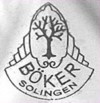 |
Solingen |
| 2 |
|
Boker |
Tree inside of double ovals |
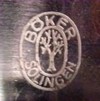 |
Solingen |
| 3 |
2 |
WKC |
Knight's head with WKC initials below. |
 |
Solingen |
| 4 |
|
WKC |
Double Knight's head |
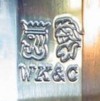 |
Solingen |
| 5 |
|
WKC |
Knight's head |
 |
Solingen |
| 6 |
3 |
Eickhorn |
Small double oval '33-'35 (1st mark) |
n/a |
Solingen |
| 7 |
|
Eickhorn |
Squirrel with sword - Acid etched '35-'41 |
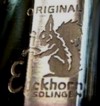 |
Solingen |
| 8 |
|
Eickhorn |
Smaller squirrel with sword stamped version '40-'41 |
n/a |
Solingen |
| 9 |
|
Eickhorn |
"Rat" Squirrel |
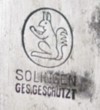 |
Solingen |
| 10 |
|
Eickhorn |
Late "over ther shoulder" squirrel stamped post '41 (large) |
n/a |
Solingen |
| 11 |
|
Eickhorn |
Late "over ther shoulder" squirrel stamped post '41(small) |
 |
Solingen |
| 12 |
|
Eickhorn |
Late "over ther shoulder" squirrel stamped post '41 (facing x-guard) |
n/a |
Solingen |
This information is brought to you courtesy of MilitaryItems.com. The premiere provider of military
collectibles to musuems, educational institutions and the general enthusiast.
|







